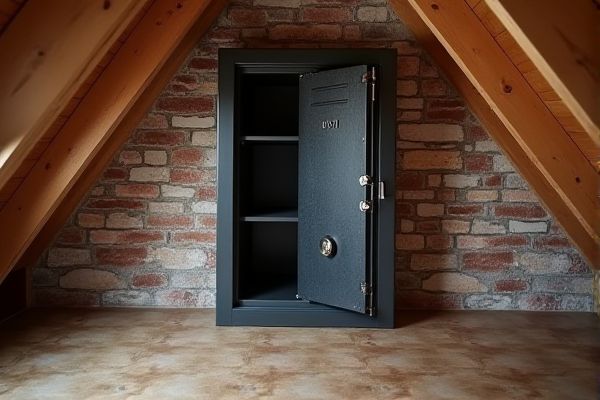
Attic steel safes offer robust protection with larger storage capacity but may be harder to install and access compared to wall safes, which provide discreet security and convenient placement within your living space. Discover the key differences between these safes to determine which option best suits your security needs in the full article.
Table of Comparison
| Feature | Attic Steel Safe | Wall Safe |
|---|---|---|
| Installation Location | Built into attic floor or accessible attic space | Recessed within wall cavities |
| Space Efficiency | Utilizes attic space, may require floor reinforcement | Compact, saves floor space |
| Security Level | High steel thickness, often heavy-duty locking, harder to detect | Concealed behind drywall, moderate to high security locks |
| Accessibility | Less convenient; requires attic access | Easy access within living space |
| Water and Fire Resistance | Depends on design, potentially less sealed | Often better sealed against fire and moisture |
| Price Range | Moderate to high due to size and material | Moderate, varies with size and fire rating |
| Ideal Use | Storing bulkier valuables or documents less frequently accessed | Important documents, jewelry, valuables for quick access |
Overview: Attic Steel Safe vs Wall Safe
Attic steel safes offer robust, fire-resistant protection designed for concealed installation in attic spaces, maximizing security without occupying valuable room. Wall safes provide discreet, flush-mounted security options easily accessible and ideal for quick access while blending seamlessly into your home's structure. Choosing between an attic steel safe and a wall safe depends on your security needs, space availability, and desired accessibility.
Security Features Comparison
Attic steel safes provide robust protection against fire and theft with thick steel construction and advanced locking mechanisms, but they may be more vulnerable to environmental factors such as moisture. Wall safes offer discreet installation and tamper-resistant bolts, making them harder for burglars to access quickly, while often featuring reinforced steel and complex combination or biometric locks for enhanced security. Comparing security features, attic steel safes excel in durability and fire resistance, whereas wall safes prioritize concealment and quick access prevention.
Installation Process and Requirements
Attic steel safes require secure anchoring to floor joists and ceiling reinforcement due to limited headspace and weight considerations, often demanding professional assessment for proper installation. Wall safes are installed between wall studs, necessitating drywall cutting and precise measurement to ensure flush fitting while maintaining wall integrity and fire resistance. Your choice depends on available space and whether you prefer concealment within a wall cavity or a sturdier, more spacious attic-safe setup.
Space and Accessibility Considerations
Attic steel safes often provide larger storage capacity but can be challenging to access due to their placement in less convenient, confined spaces. Wall safes offer easier accessibility with discreet installation typically at eye level or within reach, maximizing space efficiency in living areas. Choosing between the two depends on balancing the need for ample storage against the importance of quick and frequent access.
Protection Against Fire and Water Damage
An attic steel safe offers robust protection against fire and water damage by utilizing thick, insulated steel construction designed to withstand high temperatures and prevent water infiltration. Wall safes, while discreet and space-saving, often provide less comprehensive fire and water resistance due to thinner materials and limited sealing features. Choosing an attic steel safe can better safeguard your valuable documents and possessions from fire and water hazards, ensuring your peace of mind.
Concealment and Theft Deterrence
Attic steel safes offer superior concealment by blending into unlikely storage spaces, making them less visible to intruders and reducing the risk of theft. Wall safes provide discreet storage inside walls, allowing for easy access while remaining hidden behind pictures or furniture, enhancing theft deterrence. Both options improve security, but attic safes leverage obscurity whereas wall safes rely on integration within structural elements to prevent unauthorized access.
Cost Analysis and Value for Money
Attic steel safes generally offer a higher cost efficiency due to their larger storage capacity and robust steel construction, making them ideal for protecting valuable items against theft and fire. Wall safes, while often more expensive per cubic inch of storage, provide a discreet and space-saving solution that can be installed flush with your wall, enhancing security through concealment. Evaluating your budget against the intended use, attic steel safes deliver better value for money in bulk storage, whereas wall safes prioritize discreet protection for essential documents or smaller valuables.
Long-Term Maintenance Needs
Attic steel safes require regular inspections for moisture and temperature fluctuations to prevent rust and structural damage over time. Wall safes benefit from their embedded installation, which reduces exposure to environmental stressors and minimizes maintenance needs. Your choice between the two should factor in the long-term upkeep required to ensure optimum durability and security.
Best Use Cases for Attic Steel Safes
Attic steel safes provide optimal security for homeowners seeking discreet storage solutions in less accessible areas, protecting valuables from theft and fire damage. Ideal for storing important documents, jewelry, and firearms, these safes blend seamlessly into attic spaces, maximizing space efficiency while maintaining robust steel construction. Their placement in attics makes them less vulnerable to common break-in points compared to wall safes, enhancing overall home security.
Best Use Cases for Wall Safes
Wall safes are ideal for securing valuables in hidden, space-saving locations within the home, such as behind paintings or inside closets, offering quick yet discreet access. They provide enhanced protection against theft and fire while maximizing floor space compared to bulkier freestanding safes like attic steel safes. Commonly used for storing important documents, jewelry, cash, and small firearms, wall safes are well-suited for environments where concealment and ease of access are priorities.
 homyna.com
homyna.com